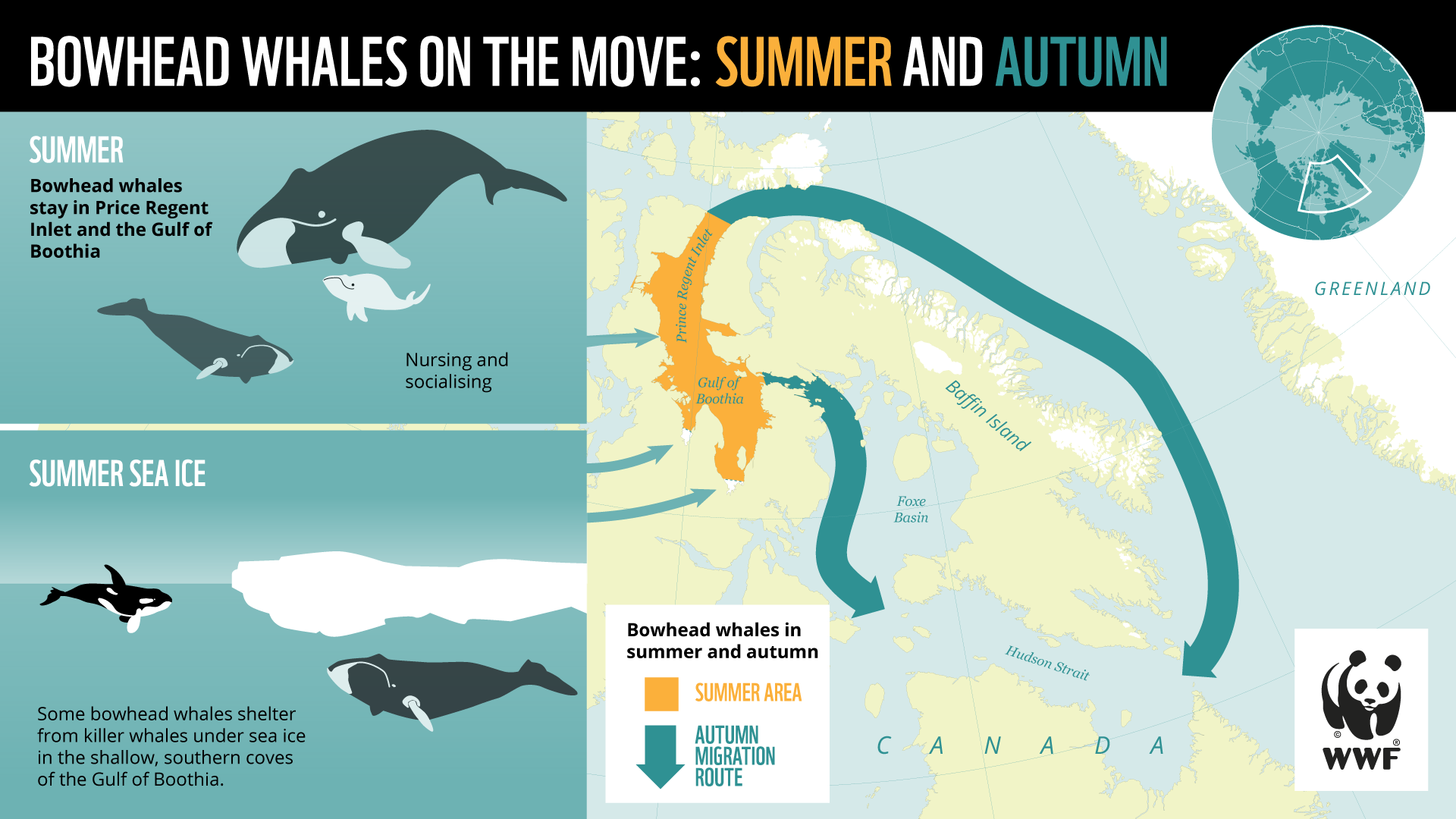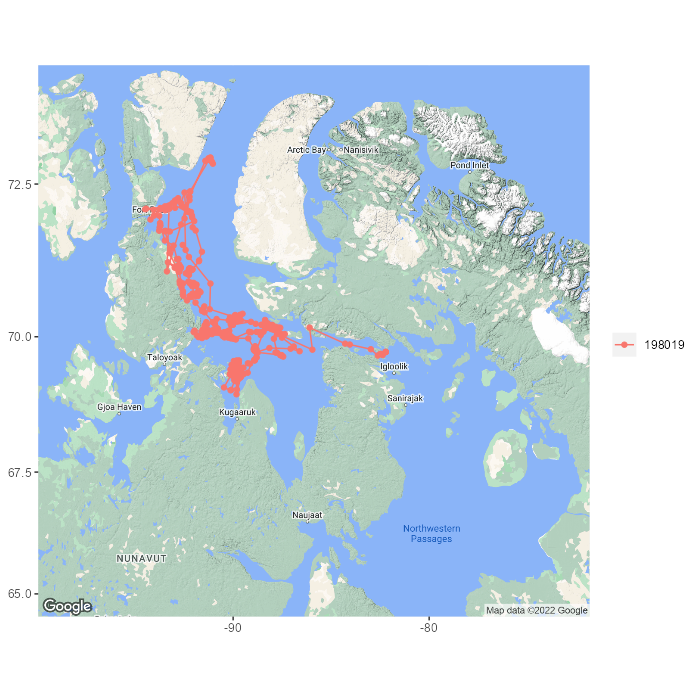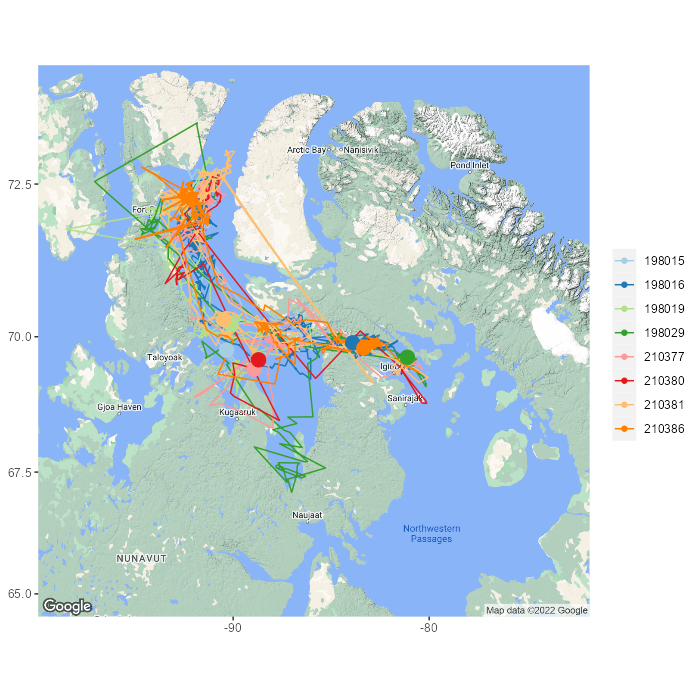© Fisheries and Oceans Canada / World Wildlife Fund Canada / VDOS Global LLC / University of British Columbia / Woods Hole Oceanographic Institution / Pangnirtung Hunter and Trappers Association and Peter’s Expediting & Outfitting Services
Features
Virtual whale watch #1: Bowhead whales in summer and autumn
- Arctic blue corridors
- Bowhead whale
- Canada
Join us for a virtual whale watch over the coming months as bowhead and other whales migrate around Arctic waters. We will follow where these whales travel in the Arctic and what their movements are telling us. In this first watch, we will explore what some bowhead whales in Arctic Canada have been doing from July until mid-October 2022.
After their spring migrations, bowhead whales take a break for a few months and spend the short Arctic summer feeding, socialising and nursing their calves. Since July, we’ve followed the movements of several bowhead whales through satellite tracking and we’re seeing some interesting behaviours and possibly some newly learned “tricks” by the planet’s longest living mammal.

© Ketill Berger / WWF. Based on work by Dr. Steve Ferguson, Fisheries and Oceans Canada and the University of Manitoba.
Bowhead whales’ movement in summer and autumn
Gulf of Boothia, Nunavut, Canada
All summer, scientists have noted that some of the tracked bowhead whales have spent a lot of time in the southern part of Prince Regent Inlet and the Gulf of Boothia, in Nunavut. Currently and surprisingly, several bowhead whales still remain in the Gulf, while others have already started their autumn migration south.
In trying to interpret and understand this behaviour, scientists note that there have been sightings of killer whales in the area this summer. They also note that although much of the sea ice melts in summer, ice gets trapped in the shallow, southern cove of the Gulf of Boothia. This thicker, multi-year sea ice provides some refuge for bowhead whales from predators such as killer whales.
From previous research, we have seen that bowhead whales swim towards the shallows in the presence of killer whales as well as seeking the sea ice remaining along the shore under which to take shelter. Since killer whales avoid ice cover, probably due to their tall dorsal fins, this is an effective way for bowheads to escape these fast-swimming hunters.
Bowhead whales are experiencing higher predation pressure from killer whales in other parts of the Arctic too, including Alaska and Russia. As a result of climate-change-caused sea ice loss, bowhead whales will need to quickly adapt to this new reality.
Bowhead whale tracks
Fury and Hecla Straits and into Foxe Basin
With autumn now here and freeze up of the ocean underway, some bowhead whales in this area tend to swim north through Prince Regent Inlet before heading south along the east coast of Baffin Island. However, as mentioned above, many bowhead whales surprisingly still remain in the Gulf of Boothia.
Other bowhead whales have already left the summering areas by swimming through the Fury and Hecla Straits, and into Foxe Basin along the west coast of Baffin Island, eventually to winter in Hudson Strait. These whales are likely a combination of juveniles and mothers travelling with and nursing their calves. They typically use the thick sea ice in Hudson Strait for protection if killer whales show up along their journey.
© Justine Hudson
VIRTUAL whale watch
Over the coming months, we will follow several bowhead whales, as well as other types of whales, on their Arctic journey.
We are supporting the work of Dr. Steve Ferguson, a scientist with Fisheries and Oceans Canada and the University of Manitoba, and colleagues to identify important habitats for whales and the migratory corridors in the Arctic and beyond.
This research will assist WWF’s Blue Corridors conservation approach, which aims to better understand whales’ migration patterns and to inform global and regional management plans that protect them. Through understanding Arctic Blue Corridors, WWF will work to mitigate threats and provide solutions to governments and industry that will safeguard whales on their journeys.
It is widely recognised that protecting and connecting areas is key to strengthening biodiversity resilience to change, giving species and ecosystems space to adapt. At the same time, human activities and industrialisation are expanding across the Arctic. This. Has put biodiversity under pressure and has occupied and fragmented an increasing number of areas across the Arctic.
WWF and partners are working towards conservation goals for Arctic priority species, like bowhead whales. This includes identifying, protecting, and connecting their important current and future habitats. Following bowhead and other whales in the Arctic will help fill some current information gaps about these Arctic animals and their key habitats.
Special thanks to Foxe Basin bowhead field research team in Igloolik that deployed satellite tags onto the whales, collected photographs both from the air and boat and sampled the whales using biopsy techniques along the floe edge in June-July 2022: Cory Matthews, Justine Hudson, Tommy Pontbriand, Todd King Ammaaq, Levi Qaunaq, Travis Qaunaq, and Morgan Martin. This project is managed by Brent Young and Steven Ferguson of Fisheries and Oceans Canada, Winnipeg. A big thank you to the Igloolik Hunters and Trappers Association, in particular the manager Jacob Maliki, for their support and assistance. Thank you as well to our Inuit colleagues based in Igloolik and Sanirayak, and to everyone who helped with truck rentals and moving gear. Financial support was provided by Fisheries and Oceans Canada and the Nunavut Wildlife Management Board.
Follow along to learn more!
Virtual whale watch series
By WWF Global Arctic Programme

